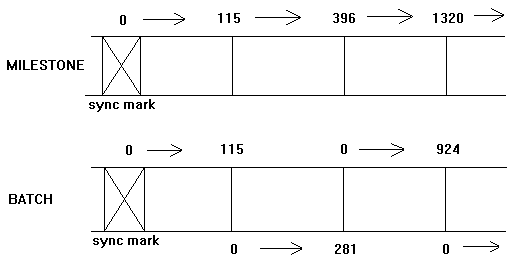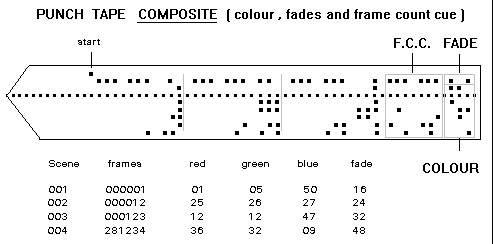F C C (Frame Count Cueing)
Most modern printers are equipped for FCC and kits are available to fit this system to other printers.
A "sync mark"[a crayon or pen mark] is placed at the start of the reel on the leader and the number of frames counted to the first light change. The frame count information is recorded manually or on a punched tape or onto computer hard disc.
A synchroniser or specially adapted grading bench is sometimes used to determine the frame count information.
Some video colour analysers are equipped to use frame count and the data is then recorded at the grading stage eliminating the separate job of cueing. Whatever method is used to record the data it must be transferred to the printing machine. The most used systems are to use punched paper tape, network the computer directly to the printing machine, or use floppy disks to transfer the information to a computer at the printer…
There are two broad types of FCC techniques.
The Milestone method
is when the light changes are recorded as frames counted from the sync mark,
which is designated s a frame count of zero. For example, the light changes
could be at 115 frames, 396 frames and 1320 frames from the sync mark.
The Batch Method.
In this case, the frame count recorded is the distance between the light
changes. The printing machine is programmed to make a change a certain number
of frames after the previous change. The frame count is reset to zero after
each change.
In the example above, the light change data would require changes at 115 frames, 281 frames and 924 frames. This is illustrated in the diagram below.

FCC Punched Tapes
Frame count punched tapes are of two types. Either two separate punched tapes, one for the FCC data and another for the printing lights required at each cued change. Alternatively, a single tape with both the FCC and the printer light data as a composite tape.


FCC is ideal for interfacing with computers and speeds up the cueing time.
It does not require the film to be damaged or handled by any additional
procedure other than that essential for grading. The only real disadvantage of
FCC is that special equipment is needed to check, or to read off the cueing
positions or printer light settings.
This is no great problem today as almost all laboratories use this system but
in the future it may be difficult to reconstruct the system once FCC has been
replaced by something else.